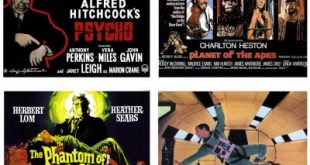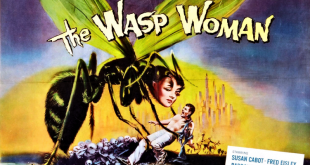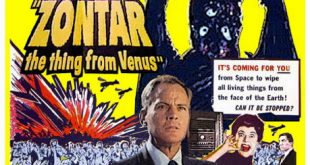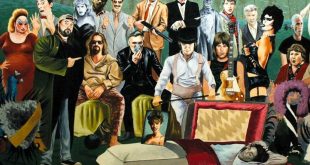 SYNOPSIS:
SYNOPSIS:
“John Haloran has a fatal heart attack, but his wife Louise won’t get any of the inheritance when Lady Haloran dies if John is dead. Louise forges a letter from John to convince the rest of his family he’s been called to New York on important business, and goes to his Irish ancestral home, Castle Haloran, to meet the family and look for a way to ensure a cut of the loot. Seven years earlier John’s sister Kathleen was drowned in the pond, and the Halorans enact a morbid ritual in remembrance. Secrets shroud the sister’s demise, and soon the family and guests begin experiencing an attrition problem.”
REVIEW:
This week I have a real treat for you. No, really! Would I lie to you? Is this the face of a lying skeleton? I mean, would I lie about this: I actually have a film for you from an Academy Award winning director. Well, no, he didn’t win the Academy Award for this one. Believe it or not, he won the Academy Award for both a film and its sequel. No, not Bob Clark for Porky’s I (1981) and Porky’s II (1983), God rest his soul. This week’s film is the first official film of Francis Ford Coppola who, of course, won Academy Awards for both The Godfather (1972) and Godfather Part II (1974).
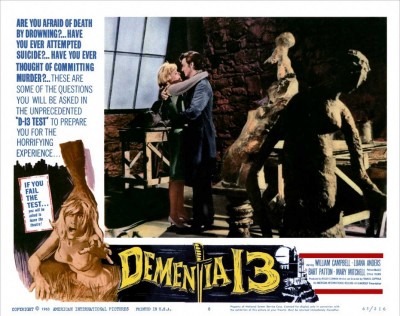 I’ll bet you’re clamouring to know why I call this Coppola’s first ‘official’ film. Before this he directed two soft-core p*rn films, The Bellboy And The Showgirls (1962) and Tonight For Sure (1962), also known as Wide Open Spaces – until the actresses complained. He left both of those off his CV. He also directed one-fifth of The Terror (1963), along with Roger Corman, Monte Hellman, Jack Hill, and a struggling young actor by the name of Jack Nicholson. I’ll get back to him later. Of course, Francis and I had worked together on the temple scene from Apocalypse Now (1979). That’s when he asked me to call him what his creditors called him: Mister Bucko. I remember his words to this day. “Nigel, you should eat more, you’re all skin and, well, bone, really. Have some of my famous Spaghetti Bolognese!” To cut a long story short, I ate his spaghetti bolognese, and that’s how I wound-up as an art installation at the Guggenheim for five months. But I digress.
I’ll bet you’re clamouring to know why I call this Coppola’s first ‘official’ film. Before this he directed two soft-core p*rn films, The Bellboy And The Showgirls (1962) and Tonight For Sure (1962), also known as Wide Open Spaces – until the actresses complained. He left both of those off his CV. He also directed one-fifth of The Terror (1963), along with Roger Corman, Monte Hellman, Jack Hill, and a struggling young actor by the name of Jack Nicholson. I’ll get back to him later. Of course, Francis and I had worked together on the temple scene from Apocalypse Now (1979). That’s when he asked me to call him what his creditors called him: Mister Bucko. I remember his words to this day. “Nigel, you should eat more, you’re all skin and, well, bone, really. Have some of my famous Spaghetti Bolognese!” To cut a long story short, I ate his spaghetti bolognese, and that’s how I wound-up as an art installation at the Guggenheim for five months. But I digress.
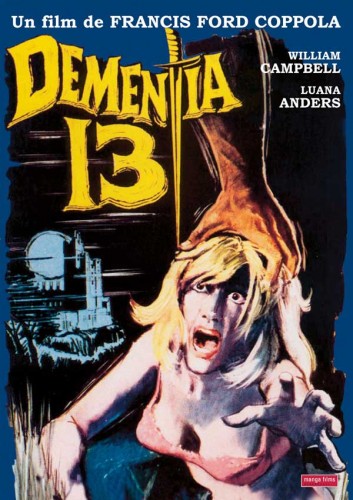
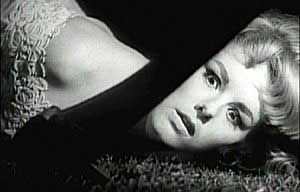 You may be wondering what happened to Dementias one through twelve. Are they lying in some film distribution centre somewhere waiting to be lovingly restored and released? Thankfully, no. The ’13’ in the title was added to differentiate it from an earlier film simply called Dementia, a concept that, in later years, Hollywood took into a dark alley and clubbed to death.
You may be wondering what happened to Dementias one through twelve. Are they lying in some film distribution centre somewhere waiting to be lovingly restored and released? Thankfully, no. The ’13’ in the title was added to differentiate it from an earlier film simply called Dementia, a concept that, in later years, Hollywood took into a dark alley and clubbed to death.
 Dementia 13 (1963) was one of a series of films that followed in the blood-flecked wake of Psycho (1960) which in turn went on to influence the slasher films of the seventies and eighties that are still being remade to this day. So cast your mind back to 1960 where Alfred Hitchcock, at the peak of his fame in Hollywood, decides to throw caution to the wind and shoot a quick black and white independent film with a television crew that was kind of like Fawlty Towers with a body count. That film was Psycho, of course, and started a wave of low-budget psychological horror films that attempted to satiate the film-goers obvious desire for necrophiliac transvestites. Speaking of transvestite necrophiliacs, I was rather fetching as Norman’s mother, even if I do say myself, and I attracted my fair share of fan mail, which I sadly had to give to the FBI Profiling Unit.
Dementia 13 (1963) was one of a series of films that followed in the blood-flecked wake of Psycho (1960) which in turn went on to influence the slasher films of the seventies and eighties that are still being remade to this day. So cast your mind back to 1960 where Alfred Hitchcock, at the peak of his fame in Hollywood, decides to throw caution to the wind and shoot a quick black and white independent film with a television crew that was kind of like Fawlty Towers with a body count. That film was Psycho, of course, and started a wave of low-budget psychological horror films that attempted to satiate the film-goers obvious desire for necrophiliac transvestites. Speaking of transvestite necrophiliacs, I was rather fetching as Norman’s mother, even if I do say myself, and I attracted my fair share of fan mail, which I sadly had to give to the FBI Profiling Unit.
This wave of Psycho films gave me a lot of work. I was forever being found behind walls or dug out of swamps or falling out of cupboards, which reminds me of my halcyon days working with William Castle. Hammer Films especially engaged with the Psycho knock-off with Maniac (1962), Nightmare (1964), Taste Of Fear (1961), Paranoiac (1963), Hysteria (1965), Fanatic (1965) and The Nanny (1965), all of which you’ll find in the Patriot Act.
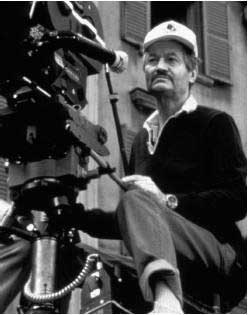 As with any emerging film trend, Roger Corman was right there at the ground level, in fact you could say he was on the basement level with A Bucket Of Blood (1959). So when Coppola came to him and said “I could take the second unit of The Young Racers (1963) and shoot a cheap Psycho knock-off in that mansion over there,” he was using two words dear to Roger Corman’s heart – ‘cheap’ and ‘knock-off’. Dementia 13 basically has two things going for it, and her name is Luana Anders. She was a popular character actress at the time, but was even better known as one of Jack Nicholson’s professional girlfriends (see, I told you I’d mention him again). She appeared in such Jack Nicholson films as Easy Rider (1969), Goin’ South (1978), and In The Hot-Tub Take 37.
As with any emerging film trend, Roger Corman was right there at the ground level, in fact you could say he was on the basement level with A Bucket Of Blood (1959). So when Coppola came to him and said “I could take the second unit of The Young Racers (1963) and shoot a cheap Psycho knock-off in that mansion over there,” he was using two words dear to Roger Corman’s heart – ‘cheap’ and ‘knock-off’. Dementia 13 basically has two things going for it, and her name is Luana Anders. She was a popular character actress at the time, but was even better known as one of Jack Nicholson’s professional girlfriends (see, I told you I’d mention him again). She appeared in such Jack Nicholson films as Easy Rider (1969), Goin’ South (1978), and In The Hot-Tub Take 37.

William Campbell was also a Corman regular, but is probably better known as the only actor to appear in every Star Trek television series. Yes, even the animated series. He did the voice of a rock but was cut out in post-production. Patrick Magee you may know from such films as A Clockwork Orange (1971), Zulu (1964) and Barry Lyndon (1975) but is probably best remembered for his dynamic portrayal of Priest in the made-for-television fantasy film Hawk The Slayer (1980). I’d like to discuss the exciting conclusion of Dementia 13, but it doesn’t really have one. Anyway, please join me next week when I have the opportunity to give you another swift kick in the good-taste unit with another terror-filled excursion to the back side of Hollywood for…Horror News! Toodles!
 Horror News | HNN Official Site | Horror Movies,Trailers, Reviews
Horror News | HNN Official Site | Horror Movies,Trailers, Reviews

